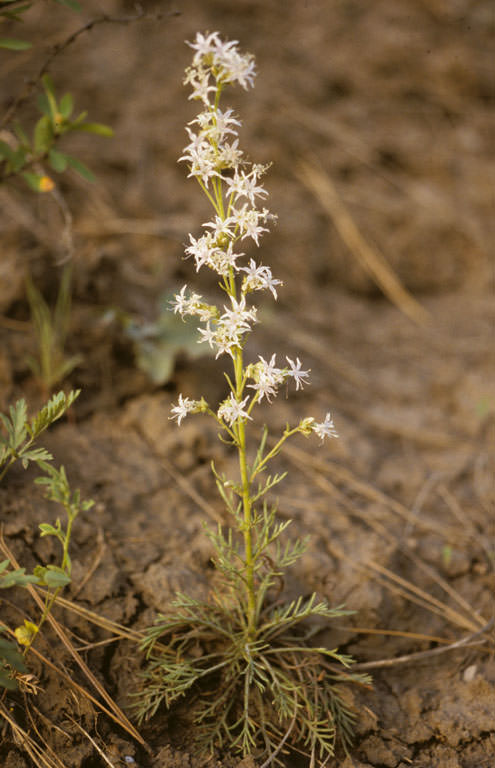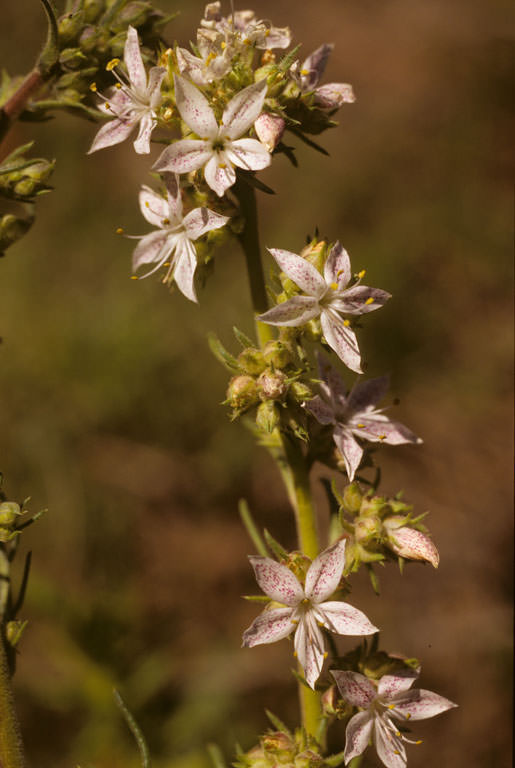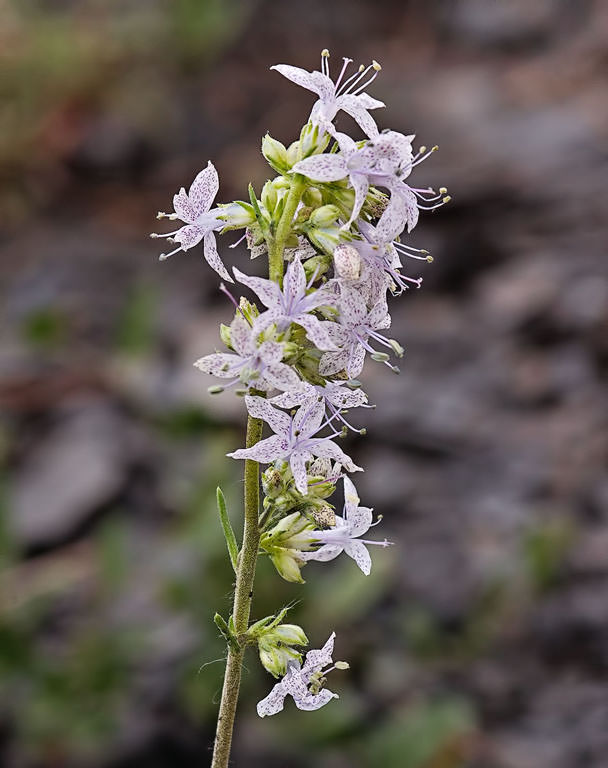Scientific Name : Ipomopsis polyantha
Author : (Rydb.) V. Grant![]() NatureServe Explorer
NatureServe Explorer
Common Name : Pagosa Skyrocket
![]() Current Research Activities
Current Research Activities
![]() 1997 profile
1997 profile
Click link below for details.
Taxonomy
Polemoniaceae (phlox family)
Ranks and Status
State Rank : S1S2
State Rank Reason : Ipomopsis polyantha is known only from a 42 sq km area in the vicinity of Pagosa Springs, Colorado, USA. Threats include commercial, residential, and municipal development; road construction and maintenance; trampling and herbivory from inappropriate livestock grazing; competition from invasive plant species; transmission line and pipeline development and maintenance; thermal energy exploration and development, and the effects of global climate change.
U.S. Endangered Species Act : ESA Endangered
Colorado Threatened and Endangered List : none
Other Statuses : SWAP Tier 1
Description and Phenology
General Description:
Herbaceous biennial, or short-lived, monocarpic perennial, over 20 cm tall. The plant typically remains as a rosette in the juvenile stage for one or two growing seasons before sending up a flowering stalk and dying, though some plants have persisted as juvenile rosettes for three or more growing seasons. Flowers are white or white with pink mottles, located in axillary clusters along the stems and branches. Corolla is short tubular, and stamens are strongly exserted. Pollen is blue initially, then changes to yellow as it matures. Leaves are pinnatifid or deeply toothed with glandular hairs (Spackman et al. 1997, Collins 1995).
Look Alikes:
Not likely to be confused with any other species in the same habitat and range in Colorado (Spackman et al. 1997).
Phenology:
Plants produce flowers and fruit late May through early August. Since the plants are most conspicuous during flowering, the best inventory period is late May to late July (Anderson 1988).
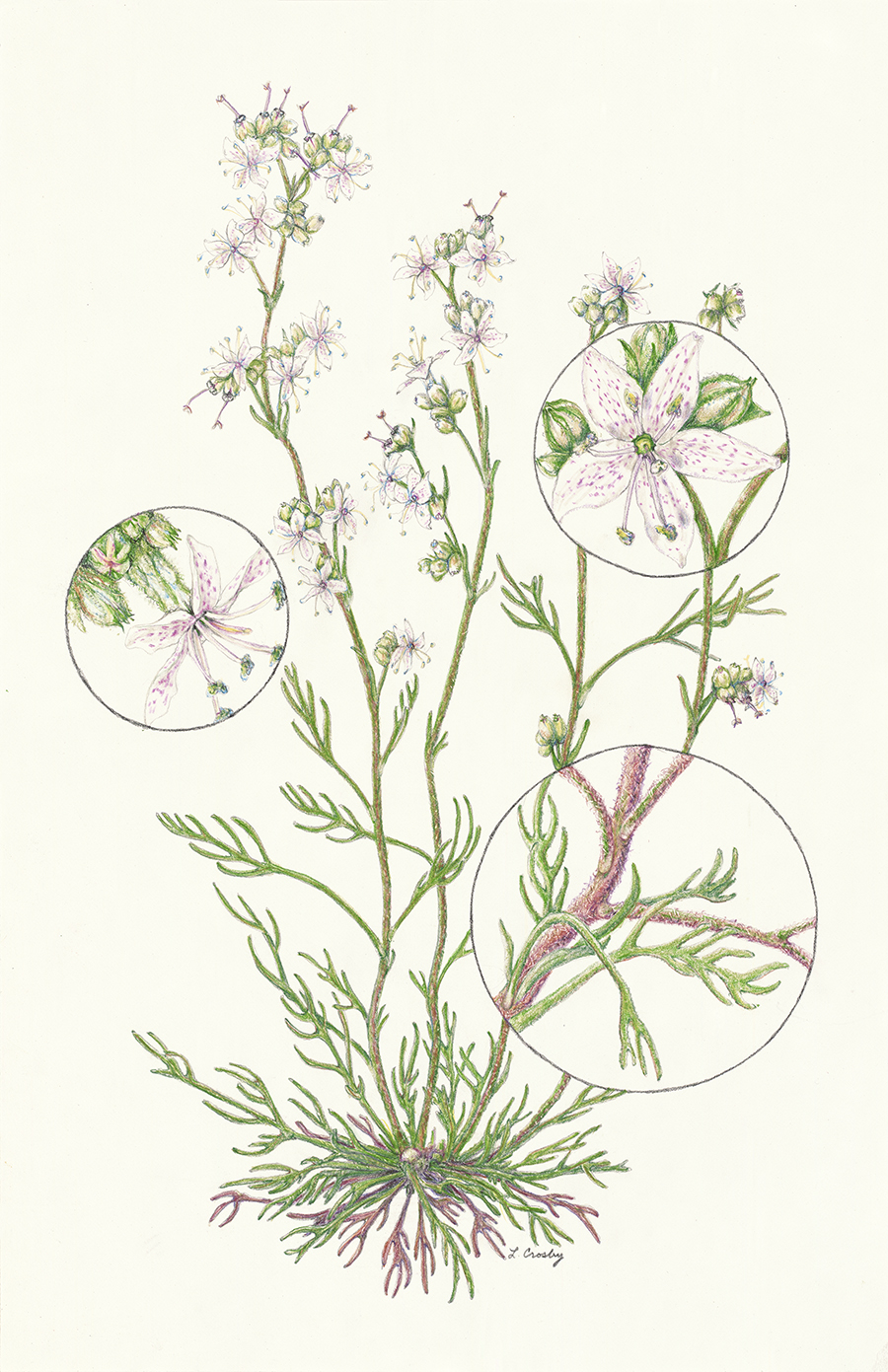 |
Habitat
This species grows on deep or moderately deep, fine-textured, light grey soils of Mancos Shale in the southern San Juan Mountains. The species is typically found growing with other herbaceous vegetation, and is not found on shale outcrops where the soil is charactizered by large particles of shale, low vegetative cover, and low water infiltration. The species is found in a variety of vegetation types on shale knolls, varying from montane meadows and rabbitbrush shrublands, openings in Ponderosa pine woodlands, sparse grasslands in abandoned or lightly grazed pasutres, or along roadsides. This species appears to be an erosion specialist that capitalizes on localized sites with higher available moisture; it is found at relatively higher densities on the toeslope of shale knolls and sides of eroded gulches which hold snowpack longer. Associated taxa include: Heterotheca villosa, Purshia tridentata, Rosa woodsii, Ericameria spp., Hymenopappus filifolius, Packera neomexicana, Allium cernuum, and Artemisia spp.
click on image to enlarge
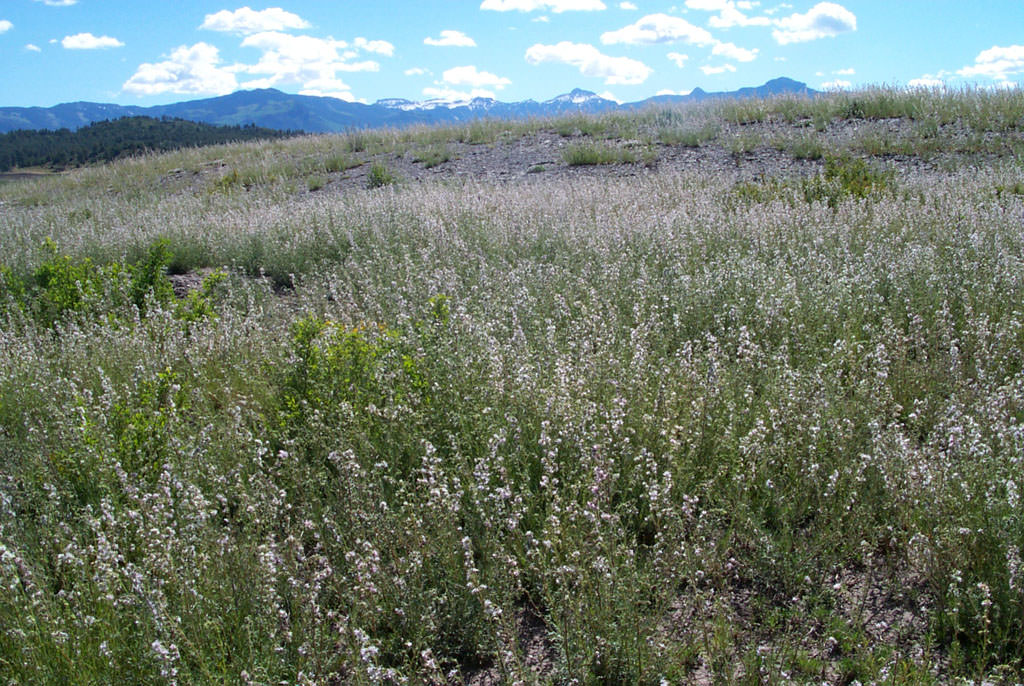 |  |
Elevation Range:
6,764 - 7,364 feet (2,062 - 2,244 meters)
Distribution
Colorado Endemic:
Yes
Range:
Ipomopsis polyantha is endemic to Archuleta County in southern Colorado, USA. Estimated range extent in Colorado of 42 square kilometers was calculated in GeoCAT using occurrence data provided by the Colorado Natural Heritage Program (2022).
 Click on map to enlarge |
Threats and Management Issues
Threats to Ipomopsis polyantha and its habitat include commercial, residential, agricultural, and municipal development; thermal energy exploration, development, and maintenance; road construction and maintenance; transmission line and pipeline development and maintenance; overgrazing; invasive plant species; and the effects of global climate change (USFWS 2020, 2022). However, nearly 90% of the plants occur on land managed by Colorado Parks and Wildlife primarily for the species conservation, thus providing protection from most anthropogenic disturbances (CPW 2017, USFWS 2020). Negative effects have been observed to Ipomopsis polyantha from overgrazing, with few plants persisting in areas of continual grazing (Collins 1995). The Colorado Natural Areas Program (2020) reports that Ipomopsis polyantha is not found in heavily grazed pastures, but individuals have been observed in lightly grazed horse pastures and abandoned pastures. Threats from road maintenance and construction are on-going as the species is often found along roadsides where some disturbance may be unavoidable. Both drought and habitat shifting and alteration due to climate change are listed as threats in Appendix A of the Colorado State Wildlife Action Plan (Handwerk et al. 2015).
 Summary results of an analysis of the status of Ipomopsis polyantha based on several ranking factors. This species was concluded to be "under conserved. From Rondeau et al. 2011. |
References
- Ackerfield, J. 2012. The Flora of Colorado. Colorado State University Herbarium. 433 pp.
- Anderson, D. G. 2004. Ipomopsis polyantha (Rydberg) V. Grant (Pagosa ipomopsis): a technical conservation assessment. [Online]. USDA Forest Service, Rocky Mountain Region. Available: http://www.fs.fed.us/r2/projects/scp/assessments/ipomopsispolyantha.pdf (accessed December 21, 2004)
- Anderson, J. 1988. Status report for Ipomopsis polyantha var polyantha. Unpublished report prepared for the US Fish and Wildlife Service, Grand Junction, CO.
- Collins, C. 1995. The Natural History and Reproductive Biology of the Pagosa Gilia, Ipomopsis polyantha (Rydberg) V. Grant var. polyantha. M.A. Thesis, California State University, Fullerton.
- Colorado Native Plant Society. 1989. Rare plants of Colorado. Rocky Mountain Nature Association, Colorado Native Plant Society, Estes Park, Colorado. 73 pp.
- Colorado Natural Areas Program (CNAP). 2020. Pagosa Skyrocket Natural Areas Monitoring Report. Colorado Parks & Wildlife.
- Colorado Natural Heritage Program (CNHP). 2022. Biodiversity Tracking and Conservation System (BIOTICS 5). Colorado Natural Heritage Program, Colorado State University, Fort Collins.
- Colorado Parks and Wildlife (CPW). 2017. Pagosa Skyrocket Natural Area Management Plan. Department of Natural Resources.
- Handwerk, J., L. Grunau, and S. Panjabi. 2015. Colorado Wildlife Action Plan: 2015 Rare Plant Addendum. Colorado Natural Heritage Program, Colorado State University, Fort Collins, Colorado, USA.
- Isberg, Karl. 1992. Rare plant species found south of town. Pagosa Springs Sun. Vol. 83 no. 40. Pagosa Springs, Archuleta County, Co 84147.
- Neely, B., S. Panjabi, E. Lane, P. Lewis, C. Dawson, A. Kratz, B. Kurzel, T. Hogan, J. Handwerk, S. Krishnan, J. Neale, and N. Ripley. 2009. Colorado Rare Plant Conservation Strategy, Developed by the Colorado Rare Plant conservation Initiative. The Nature Conservancy, Boulder, Colorado, 117 pp.
- Porter, J.M., L.A. Johnson, and D. Wilken. 2010. Phylogenetic systematics of Ipomopsis (Polemoniaceae): Relationships and divergence times estimated from chloroplast and nuclear DNA sequences. Systematic Botany 35(1):181-200.
- Rocky Mountain Society of Botanical Artists. 2009. RARE Imperiled Plants of Colorado, a traveling art exhibition. Exhibition catalogue developed by the Denver Botanic Gardens and Steamboat Art Museum.
- Rondeau, R., K. Decker, J. Handwerk, J. Siemers, L. Grunau, and C. Pague. 2011. The state of Colorado's biodiversity 2011. Prepared for The Nature Conservancy. Colorado Natural Heritage Program, Colorado State University, Fort Collins, Colorado.
- Smith, J.P. 2020. Pagosa skyrocket (Ipomopsis polyantha) Range-wide Monitoring, 2020. Colorado Natural Heritage Program, Colorado State University, Fort Collins, Colorado.
- Smith, J.P. 2022. Pagosa skyrocket (Ipomopsis polyantha) Range-wide Monitoring, 2021. Colorado Natural Heritage Program, Colorado State University, Fort Collins, Colorado.
- Spackman, S., B. Jennings, J. Coles, C. Dawson, M. Minton, A. Kratz, and C. Spurrier. 1997. Colorado rare plant field guide. Prepared for Bureau of Land Management, U.S. Forest Service and U.S. Fish and Wildlife Service by Colorado Natural Heritage Program.
- U.S. Fish and Wildlife Service (USFWS). 2005. Endangered and Threatened Wildlife and Plants; Review of Native Species that are Candidates or Proposed for Listing as Endangered or Threatened; Annual Notice of Findings on Resubmitted Petitions; Annual Description of Progress on Listing Actions; Proposed Rule. Federal Register 70(90):24870-24934. May 11, 2005.
- U.S. Fish and Wildlife Service (USFWS). 2010. Endangered and Threatened Wildlife and Plants; Listing Ipomopsis polyantha (Pagosa Skyrocket) as Endangered Throughout Its Range, and Listing Penstemon debilis (Parachute Beardtougue) and Phacelia submutica (DeBeque Phacelia) as Threatened Throughout Their Range. Proposed Rule. Federal Register 75(120):35721-35746.
- U.S. Fish and Wildlife Service (USFWS). 2011. Determination of Endangered Status for Ipomopsis polyantha (Pagosa Skyrocket) and Threatened Status for Penstemon debilis (Parachute Beardtongue) and Phacelia submutica. Federal Register 76(145): 45054-45075.
- U.S. Fish and Wildlife Service. 2020. Species status assessment report for Pagosa skyrocket (Ipomopsis polyantha). Lakewood, Colorado. 38 pp. Online. Available: https://fws.gov/species/pagosa-ipomopsis-ipomopsis-polyantha (Accessed 2022).
- U.S. Fish and Wildlife Service. 2022. Recovery plan for Pagosa Skyrocket (Ipomopsis polyantha). July 2022. U.S. Fish and Wildlife Service, Upper Colorado Basin Region, Lakewood, Colorado. 19 pages. Online. Available: https://fws.gov/species/pagosa-ipomopsis-ipomopsis-polyantha (Accessed 2022).
- USDA, NRCS. 2022. The PLANTS Database. National Plant Data Team, Greensboro, NC 27401-4901 USA.
- Weber, W. A. and R. C. Wittmann. 2012. Colorado Flora, Western Slope, A Field Guide to the Vascular Plants, Fourth Edition. Boulder, Colorado. 532 pp.


